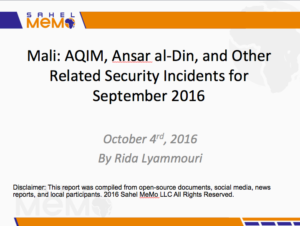By Rida Lyammouri
October 4th, 2016
Violence by violent extremist organizations (VEOs) continued in September 2016 and Ansar al-Din remained the most active in Mali. Most of the attacks conducted in northern and central Mali were claimed by the group through its media arm al-Rimah. Ansar al-Din also stepped up its media campaign and released two high quality videos of an attack on Malian Army convoy and showing spoils of a previous attack. Suspected VEO [though can’t be confirmed] members attacked and seized control of Boni village in Mopti Region led to the firing of Malian defense minister and demonstrated inability of local forces to prevent and stop VEO attacks. Attacks by Ansar al-Din, AQIM, and allies included the use of improvised explosive device (IED), assassinations, and ambush against Malian and foreign forces. In Mali’s neighbor Burkina Faso, September witnessed first attack by Adnan Abu Walid al-Sahraoui’s men who pledged allegiance to the so-called Islamic State.
Ongoing violence in September between armed groups in northern Mali further complicated implementation of the peace process. Deadly clashes between CMA and GATIA in Kidal Region is slowing any attempt of running joint patrols as agreed in September 15th. As a result of this violence United States Ambassador for the first time have called the Malian government to cut ties with GATIA, a group that has been suspected to be created and backed by Malian authorities in August 2015.
Armed banditry against non-government organizations (NGOs) in Ménaka and civilian transportation also remains a main threat to stability in central and northern Mali. For instance drivers protested against insecurity between Gao and Ménaka and complained about lack of permanent security presence on one of the most dangerous transit routes in northern Mali.
Full Report: september-security-tracker-mali


Je suis très déçu par le fait qu’il n’y ait aucune réaction de la part du gouvernement malien face la déclaration de l’ambassadeur du Mali.
Je suis très déçu par le fait qu’il n’y ait aucune réaction de la part du gouvernement malien face à la déclaration de l’ambassadeur des USA
Oui, vraiment bizarre le fait qu’ils n’ont fait aucun commentaire, c’est l’acte de quelqu’un qui est coupable! Bon, ésperant que les choses vont se calmer pour aider la pauvre population qui n’ont rien a voir avec cette violence inshallah.
Personnellement je suis surpris de cette accusation vu l’indifférence des USA depuis les négociations jusqu’à l’application des accords de paix. Du jour au lendemain on se lève pour dire que c’est un tel qui est entrain d’entravé le retour de la paix.
Oui la réaction des USA doit etre en réponse de quelque chose qui ont remarqué….!
Donc c’est aujourd’hui que les USA ont commencé à faire des remarques. Sinon tous les groupes armés d’une manière ou d’une autre (officieusement ou officiellement) ont usé des leurs relations avec certains états qui n’ont jamais dénoncé par les USA. Exemple : le MNLA avec la France